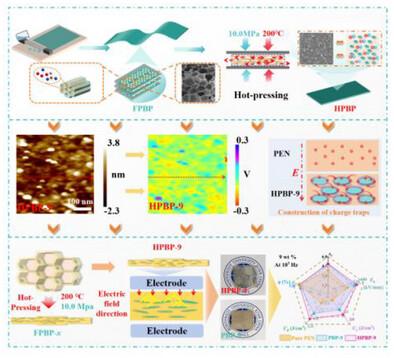Enhancing Dielectric Energy Storage Properties of Poly(Arylene Ether Nitrile) Via Controlling the Distribution of Boron Nitride Nanosheets
IF 19
1区 材料科学
Q1 CHEMISTRY, MULTIDISCIPLINARY
引用次数: 0
Abstract
Effectively regulating the filler distribution in polymer dielectric energy storage materials is crucial for enhancing their energy storage properties. In the current work, a novel strategy is proposed to improve the distribution of boron nitride nanosheets (BNNS) in poly(arylene ether nitrile) (PEN) for enhanced dielectric energy storage performances by combining phase inversion and the hot-pressing method. PEN-grafted BNNS (PEN@BNNS) is first prepared, carefully characterized, and then incorporated into the PEN matrix via phase inversion followed by hot-pressing, yielding hot-pressed PEN@BNNS/PEN (HPBP-x) composite films. The SEM, TEM images, and physical pictures, together with enhanced thermal and mechanical properties of HPBP-x confirmed this improved distribution of BNNS in PEN. As a result, the HPBP-9 demonstrates simultaneously enhanced dielectric constant of 4.87 and breakdown strength of 323.3 kV mm−1, along with an excellent discharge energy density (Ud) of 2.09 J cm−3. Moreover, the charge–discharge efficiency is over 95% with excellent stability after 104 cycles. The phase inversion combined with hot-pressing effectively improves the distribution of PEN@BNNS in PEN and significantly enhances the dielectric performances of PEN-based dielectrics, providing new insights for developing flexible dielectric energy storage materials.

通过控制氮化硼纳米片的分布来提高聚芳醚腈的介电储能性能
有效调节聚合物介质储能材料中的填料分布是提高聚合物介质储能材料储能性能的关键。本文提出了一种结合相变和热压相结合的方法来改善氮化硼纳米片(BNNS)在聚芳醚腈(PEN)中的分布,从而提高其介电储能性能的新策略。首先制备了PEN接枝的BNNS (PEN@BNNS),仔细表征,然后通过相转化和热压结合到PEN基体中,得到热压PEN@BNNS/PEN (HPBP-x)复合薄膜。扫描电镜、透射电镜和物理图像,以及HPBP-x增强的热性能和力学性能证实了BNNS在PEN中的分布得到改善。结果表明,HPBP-9的介电常数为4.87,击穿强度为323.3 kV mm−1,放电能量密度(Ud)为2.09 J cm−3。经104次循环后,充放电效率可达95%以上,稳定性极佳。相变结合热压有效改善了PEN@BNNS在PEN中的分布,显著提高了PEN基介电材料的介电性能,为开发柔性介电储能材料提供了新的思路。
本文章由计算机程序翻译,如有差异,请以英文原文为准。
求助全文
约1分钟内获得全文
求助全文
来源期刊

Advanced Functional Materials
工程技术-材料科学:综合
CiteScore
29.50
自引率
4.20%
发文量
2086
审稿时长
2.1 months
期刊介绍:
Firmly established as a top-tier materials science journal, Advanced Functional Materials reports breakthrough research in all aspects of materials science, including nanotechnology, chemistry, physics, and biology every week.
Advanced Functional Materials is known for its rapid and fair peer review, quality content, and high impact, making it the first choice of the international materials science community.
 求助内容:
求助内容: 应助结果提醒方式:
应助结果提醒方式:


